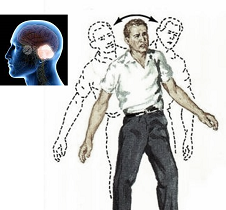Ataxia refers to a loss of coordination and balance, that causes difficulty in speech and swallowing, unsteady walking, hand clumsiness, and affected eye movements.
Ataxia is actual loss of balance and coordination and should be differentiated from dizziness. The walking is unsteady or with the feet set wide apart to maintain better balance, difficulty with fine motor tasks (such as eating, writing, stitching, tying laces, or buttoning a shirt), change/difficulty in speech (dysarthria), difficulty in swallowing, and back-and-forth involuntary eye movements (called nystagmus).
CAUSES
Ataxia is caused by damage to the part of the brain (Cerebellum) or its neural connections, that control balance, and muscle coordination. It can occur due to acquired or hereditary causes.
Acquired causes:
- Alcohol (temporary ataxia due to too much intake at one time, or persistent ataxia due to long-term excess intake).
- Vitamin deficiency (B1, B12, B6)
- Medications (side effect of medicines like barbiturates like phenobarbital, benzodiazepines like diazepam; antiepileptic drugs like phenytoin and some types of chemotherapy).
- Infections (usually viral – exanthems, COVID, HIV)
- Toxins (metal poisoning -lead, mercury, solvents and thinners)
- Stroke
- Brain abscess (an infection causing pus collection and pressure on the cerebellum)
- Brain tumor (causing pressure on cerebellum)
- Head injury
- Thyroid problems
- Multiple sclerosis
- Autoimmune diseases (abnormal immune response to body’s own part/s) or Paraneoplastic syndromes (abnormal immune response to cancer).
- Cerebral palsy (a disorder caused by damage to a child’s brain during early development: before, during or shortly after birth; affecting the child’s ability to coordinate body movements).
- Multiple system atrophy (a rare condition affecting adults around 50 years causing ataxia, bladder incontinence, low blood pressure, fainting, and abnormal REM sleep behavior disorder (yelling, kicking or punching in sleep).
Hereditary causes:
These are caused due to inherited or mutated genetic abnormalities of proteins in the cerebellum. The defect comes from either a dominant gene from one parent (autosomal dominant disorder – one parent suffers) or a recessive gene from both parents (autosomal recessive disorder – the parents are unaffected, but a sibling may suffer from that ataxia).
Autosomal dominant types includes spinocerebellar ataxia (progressive degenerative) and episodic ataxia (brief episodes triggered by stress, sudden movement and startling, associated with muscle twitching, and weakness).
Autosomal recessive types includes the following:
- Friedreich’s ataxia (most common hereditary ataxia) – It involves damage to the cerebellum, spinal cord and peripheral nerves. It appears much before 25 years of age manifesting with difficulty in walking, progressing to abnormal arm-trunk coordination, arch deformities of the feet and spine (scoliosis), along with abnormal speech (slurred), weakness, and involuntary eye movements. Complications include heart enlargement (cardiomyopathy) and heart failure, and diabetes.
- RFC1 associated ataxia – A late onset ataxia with dizziness, numbness or tingling in the body, and sometimes unexplained cough.
- Ataxia-telangiectasia – A rare, progressive childhood disease manifesting with motor skill development, poor balance and slurred speech, along with increased risk of cancer and frequent infections. Telangiectasia is the formation of tiny red “spider” veins that appear in the corners of the child’s eyes, ears and cheeks.
- Congenital cerebellar ataxia – Occurs due to damage to the cerebellum present at birth.
- Wilson’s disease – A condition causing copper to accumulate in the brain, liver and other organs. This can cause ataxia and other neurological problems like abnormal involuntary movements (dyskinesia), and also lead to liver damage and cirrhosis.
Sensory ataxia
It is caused by loss of sensory input through the nerves and spinal cord to the cerebellum, and not by the cerebellum itself. When eyes are open, sensory input comes in through the eyes, and ataxia does not manifest. These patients usually complain of ataxia when their eyes are closed while clothing, showering, etc., or in the dark, when the cerebellum depends on sensory inputs (proprioception) from various body parts through nerves and the spinal cord, which are damaged or malfunctioning.
In sensory ataxia speech and eye movements are usually normal, but handwriting may be affected. The causes include some neuropathies, infections, blood flow (vascular) problems, autoimmune or metabolic diseases, and toxicities affecting the nerve pathways through the spinal cord to the cerebellum.
MANAGEMENT
The doctor will make a diagnosis based on history and clinical examination. He may also perform certain tests (blood tests, imaging -MRI, lumbar puncture or spinal tap) to rule out underlying conditions if suspected. Genetic testing may also be advised.
The Romberg test differentiates sensory ataxia from cerebellar causes. The patient stands erect with hands stretched and eyes closed. Swaying to one side with eyes closed but maintaining posture with eyes open is suggestive of sensory ataxia.
There is no specific treatment for ataxia as such, but underlying conditions should be meticulously treated. Adaptive devices like hiking sticks or walkers for walking, Modified utensils for eating and speaking aids are available. Therapies like physical therapy and aerobic exercises (to help coordination and enhance mobility), occupational therapy (to help with daily living tasks) and speech therapy (to improve speech and aid swallowing) may be very useful to improve quality of life.
Also read:
Hyperkinetic Movement Disorders – Understanding 5 Types of Dyskinesia


